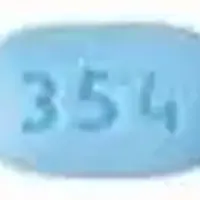Generic name: keppra
Availability: Prescription only
Pregnancy & Lactation: Risk data available
Brand names: Keppra, Spritam, Levetiracetam (oral/injection)
What is Levetiracetam (monograph)?
Introduction
Anticonvulsant; a pyrrolidine derivative.
Uses for Levetiracetam
Seizure Disorders
Conventional (immediate-release) tablets, oral solution, and injection: Management (in combination with other anticonvulsants) of partial onset seizures in patients ≥1 month of age, myoclonic seizures in patients ≥12 years of age, and primary generalized tonic-clonic seizures in patients ≥6 years of age.
Extended-release tablets: Management (in combination with other anticonvulsants) of partial onset seizures in patients ≥12 years of age.
Also commercially available as an IV formulation for management of such seizure disorders when oral therapy temporarily not feasible.
Levetiracetam Dosage and Administration
General
-
Withdraw gradually (e.g., by reducing dosage by 1 g daily at 2-week intervals) to minimize potential for increased seizure frequency. (See Discontinuance of Therapy under Cautions.)
-
Closely monitor for notable changes in behavior that could indicate emergence or worsening of suicidal thoughts or behavior or depression. (See Suicidality Risk under Cautions.)
Administration
Administer orally (as immediate-release tablets, extended-release tablets, or oral solution); may be administered by IV infusion when oral therapy temporarily not feasible.
Commercially available levetiracetam conventional (immediate-release) tablets, oral solution, and IV formulations are bioequivalent.
Oral Administration
Immediate-release Tablets
Administer twice daily without regard to meals.
Swallow tablets whole; do not chew or crush.
Oral Solution
Administer twice daily without regard to meals.
Use a calibrated dosing device to measure and administer oral solution; household teaspoon or tablespoon not an adequate measuring device.
Extended-release Tablets
Administer once daily.
Swallow tablets whole; do not chew, break, or crush.
IV Administration
For solution and drug compatibility information, see Compatibility under Stability.
Dilution
Must dilute levetiracetam concentrate for injection prior to use. Withdraw appropriate dose and dilute in 100 mL of 0.9% sodium chloride injection, lactated Ringer’s, or 5% dextrose injection. May use a smaller volume of diluent if necessary (e.g., in pediatric patients or patients who may be susceptible to fluid volume overload), but concentration of diluted solution should not exceed 15 mg/mL. Discard unused contents of vial after use.
Alternatively, may use commercially available premixed injection (containing 500 mg, 1 g, or 1.5 g of levetiracetam in sodium chloride 0.82, 0.75, or 0.54%, respectively) without further dilution in adults ≥16 years of age. For doses that are not commercially available as a premixed solution (e.g., 250 or 750 mg), withdraw appropriate volume from commercial infusion bag and transfer to a separate sterile, empty infusion bag. Discard unused contents of original infusion bag; do not reuse or store.
Rate of Administration
Administer by IV infusion over 15 minutes. Do not use in series connections.
Dosage
When switching from oral to IV therapy, initial total daily IV dosage should be equivalent to daily dose and frequency of oral therapy. At completion of the IV treatment period, may switch back to oral therapy at same daily dose and frequency as IV therapy.
Pediatric Patients
Seizure Disorders
Partial Seizures in Pediatric Patients 1 to <6 Months of Age (Immediate-release Preparations)
OralChildren weighing ≤20 kg should receive oral solution.
Initially, 14 mg/kg daily (administered as 7 mg/kg twice daily). Increase by 14 mg/kg daily at 2-week intervals up to recommended dosage of 42 mg/kg daily (administered as 21 mg/kg twice daily).
In clinical trial, mean daily dosage was 35 mg/kg in this age group; efficacy of lower dosages not established.
IVWhen oral therapy temporarily not feasible, may administer by IV infusion at same dosages recommended above.
Partial Seizures in Pediatric Patients 6 months to <4 Years of Age (Immediate-release Preparations)
OralChildren weighing ≤20 kg should receive oral solution; children weighing >20 kg may receive either tablets or oral solution.
Initially, 20 mg/kg daily (administered as 10 mg/kg twice daily).
Increase by 20 mg/kg daily at 2-week intervals up to recommended dosage of 50 mg/kg daily (administered as 25 mg/kg twice daily).
May reduce dosage if patient unable to tolerate a dosage of 50 mg/kg daily. In clinical trial, mean daily dosage was 47 mg/kg in this age group.
IVWhen oral therapy temporarily not feasible, may administer by IV infusion at same dosages recommended above.
Partial Seizures in Pediatric Patients 4 to <16 Years of Age (Immediate-release Preparations)
OralChildren weighing ≤20 kg should receive oral solution; children weighing >20 kg may receive either tablets or oral solution.
Initially 20 mg/kg daily (administered as 10 mg/kg twice daily).
Increase by 20 mg/kg daily at 2-week intervals up to recommended dosage of 60 mg/kg daily (administered as 30 mg/kg twice daily).
May reduce dosage if patient unable to tolerate a dosage of 60 mg/kg daily. In clinical trial, mean daily dosage was 44 mg/kg and maximum daily dosage was 3 g daily.
Immediate-release tablets in pediatric patients weighing 20–40 kg: Initially, 500 mg daily (administered as 250 mg twice daily); may increase dosage by 500 mg daily every 2 weeks up to maximum of 1.5 g daily (administered as 750 mg twice daily).
Immediate-release tablets in pediatric patients weighing >40 kg: Initially, 1 g daily (administered as 500 mg twice daily); may increase dosage by 1 g daily every 2 weeks up to maximum of 3 g daily (administered as 1.5 g twice daily).
IVWhen oral therapy temporarily not feasible, may administer by IV infusion at same dosages recommended above.
Partial Seizures in Pediatric Patients ≥12 Years of Age (Extended-release Tablets)
OralInitially, 1 g once daily. May increase by 1 g daily at 2-week intervals up to maximum recommended dosage of 3 g daily.
Myoclonic Seizures in Pediatric Patients ≥12 Years of Age
OralInitially, 1 g daily (administered as 500 mg twice daily as immediate-release preparations).
May increase by 1 g daily at 2-week intervals up to recommended dosage of 3 g daily (administered as 1.5 g twice daily). Efficacy of dosages <3 g daily not established.
IVWhen oral therapy is temporarily not feasible, may administer by IV infusion at same dosages recommended above.
Primary Generalized Tonic-Clonic Seizures in Pediatric Patients 6 to <16 Years of Age
OralChildren weighing ≤20 kg should receive oral solution; children weighing >20 kg may receive either the immediate-release tablets or oral solution.
Initially, 20 mg/kg daily (administered as 10 mg/kg twice daily as immediate-release preparations).
May increase by 20 mg/kg daily at 2-week intervals up to recommended dosage of 60 mg/kg daily. Efficacy of dosages <60 mg/kg daily not established.
IVWhen oral therapy temporarily not feasible, may administer by IV infusion at same dosages recommended above.
Adults
Seizure Disorders
Partial Seizures in Adults ≥16 Years of Age
OralInitially, 1 g daily (administered as 500 mg twice daily as immediate-release tablets or oral solution, or 1 g once daily as extended-release tablets).
May increase by 1 g daily at 2-week intervals up to maximum of 3 g daily.
Some clinicians reportedly initiate therapy with dosages of 2–4 g daily.
Dosages >3 g daily may not be associated with increased therapeutic benefit.
IVWhen oral therapy temporarily not feasible, may administer by IV infusion at same dosages recommended above.
Myoclonic Seizures in Adults ≥16 Years of Age
OralInitially, 1 g daily (administered as 500 mg twice daily as immediate-release preparations).
May increase by 1 g daily at 2-week intervals up to recommended dosage of 3 g daily (administered as 1.5 g twice daily). Efficacy of dosages <3 g daily not established.
IVWhen oral therapy temporarily not feasible, may administer by IV infusion at same dosages recommended above.
Primary Generalized Tonic-Clonic Seizures in Adults ≥16 Years of Age
OralInitially, 1 g daily (administered as 500 mg twice daily as immediate-release preparations).
May increase by 1 g daily at 2-week intervals up to recommended dosage of 3 g daily (administered as 1.5 g twice daily). Efficacy of dosages <3 g daily not established.
IVWhen oral therapy temporarily not feasible, may administer by IV infusion at same dosages recommended above.
Prescribing Limits
Pediatric Patients
Seizure Disorders
Partial Seizures
Oral/IVManufacturer recommends maximum of 3 g daily in pediatric patients weighing >40 kg and maximum of 1.5 g daily in pediatric patients weighing 20–40 kg.
Adults
Seizure Disorders
Partial Seizures
Oral/IVMaximum 3 g daily recommended by the manufacturer.
Special Populations
Hepatic Impairment
No dosage adjustment necessary in patients with hepatic impairment.
Renal Impairment
Modify dosage according to the degree of impairment based on patient’s measured or estimated Clcr adjusted for body surface area. (See Tables 1 and 2.)
|
Renal Function |
Clcr (mL/minute per 1.73 m2) |
Dosage |
|---|---|---|
|
Normal |
>80 |
500–1500 mg every 12 hours |
|
Mild |
50–80 |
500–1000 mg every 12 hours |
|
Moderate |
30–50 |
250–750 mg every 12 hours |
|
Severe |
<30 |
250–500 mg every 12 hours |
|
Patients with end-stage renal disease undergoing dialysis |
– |
500–1000 mg every 24 hours; following dialysis, a 250- to 500-mg supplemental dose is recommended |
|
Renal Function |
Clcr (mL/minute per 1.73 m2) |
Dosage |
|---|---|---|
|
Normal |
>80 |
1000–3000 mg every 24 hours |
|
Mild |
50–80 |
1000–2000 mg every 24 hours |
|
Moderate |
30–50 |
500–1500 mg every 24 hours |
|
Severe |
<30 |
500–1000 mg every 24 hours |
Geriatric Patients
Select dosage carefully and consider monitoring renal function during therapy.
Warnings
Contraindications
-
Known hypersensitivity to levetiracetam.
Warnings/Precautions
Warnings
Nervous System Effects
Possible adverse neuropsychiatric effects are classified into 3 categories: somnolence and fatigue; coordination difficulties; behavioral changes.
Somnolence, asthenia, and coordination difficulties occur most frequently within first 4 weeks of treatment.
Psychotic manifestations, sometimes requiring hospitalization, reported.
Nonpsychotic behavioral symptoms (e.g., aggression, agitation, anger, anxiety, apathy, depersonalization, depression, emotional lability, hostility, hyperkinesias, irritability, nervousness, neurosis, personality disorder) also reported.
Monitor for adverse neuropsychiatric effects during therapy. Advise patients not to drive or operate machinery until the effects of levetiracetam are known.
Suicidality Risk
Increased risk of suicidality (suicidal behavior or ideation) observed in an analysis of studies using various anticonvulsants in patients with epilepsy, psychiatric disorders (e.g., bipolar disorder, depression, anxiety), and other conditions (e.g., migraine, neuropathic pain); risk in patients receiving anticonvulsants (0.43%) was approximately twice that in patients receiving placebo (0.24%). Increased suicidality risk was observed ≥1 week after initiation of anticonvulsant therapy and continued through 24 weeks. Relative risk was higher for patients with epilepsy compared with those receiving anticonvulsants for other conditions.
Closely monitor all patients currently receiving or beginning anticonvulsant therapy for changes in behavior that may indicate emergence or worsening of suicidal thoughts or behavior or depression. Anxiety, agitation, hostility, insomnia, and mania may be precursors to emerging suicidality.
Balance risk of suicidality with risk of untreated illness. Epilepsy and other illnesses treated with anticonvulsants are themselves associated with morbidity and mortality and an increased risk of suicidality. If suicidal thoughts or behavior emerges during anticonvulsant therapy, consider whether these symptoms may be related to the illness itself. (See Advice to Patients.)
Dermatologic Reactions
Serious dermatologic reactions, including Stevens-Johnson syndrome (SJS) and toxic epidermal necrolysis (TEN), reported. Median time to onset usually 14–17 days, but may occur months after initiation of therapy.
Discontinue drug at first sign of rash, unless clearly not drug-related. If manifestations suggestive of SJS or TEN occur, permanently discontinue; consider alternative therapy.
Discontinuance of Therapy
Abrupt withdrawal may result in increased seizure frequency or status epilepticus. (See General under Dosage and Administration.)
Hematologic Effects
Hematologic abnormalities (e.g., decreased RBC, WBC, and neutrophil counts) reported in clinical studies. Agranulocytosis, leukopenia, neutropenia, pancytopenia, and thrombocytopenia also have occurred during postmarketing experience.
Monitor CBC in patients who experience any signs or symptoms of hematologic abnormalities (e.g., severe weakness, pyrexia, recurrent infections, coagulation disorders).
Increased BP
Increased diastolic BP observed in pediatric patients 1 month to <4 years of age; monitor such patients during therapy.
Seizure Control During Pregnancy
Physiologic changes that occur during pregnancy may gradually decrease plasma levels of levetiracetam in pregnant women. Most notable during third trimester.
Closely monitor during pregnancy and throughout postpartum period, particularly if dosage is adjusted during pregnancy.
Sensitivity Reactions
Anaphylaxis and Angioedema
Anaphylaxis and angioedema, in some cases life-threatening and/or requiring emergency treatment, reported. (See Contraindications under Cautions.)
Discontinue immediately and seek medical attention if any signs or symptoms occur. Manifestations have included hypotension, hives, rash, respiratory distress, facial swelling, and swelling of the tongue, throat, and feet. Permanently discontinue if an alternative etiology cannot be identified.
General Precautions
Possible Prescribing and Dispensing Errors
Ensure accuracy of prescription; similarity in spelling of Keppra (levetiracetam) and Kaletra (fixed combination of lopinavir and ritonavir, both antiretroviral agents) may result in errors.
Specific Populations
Pregnancy
Category C.
North American Antiepileptic Drug (NAAED) Pregnancy Registry at 888-233-2334.
Lactation
Distributed into milk. Discontinue nursing or the drug because of potential risk in nursing infant.
Pediatric Use
Safety and efficacy of immediate-release tablets, oral solution, and injection for management of partial onset seizures not established in children <1 month of age.
Safety and efficacy of immediate-release tablets, oral solution, and injection for management of myoclonic seizures not established in pediatric patients <12 years of age.
Safety and efficacy of immediate-release tablets, oral solution, and injection for management of primary generalized tonic-clonic seizures not established in children <6 years of age.
Safety and efficacy of extended-release tablets not established in children <12 years of age.
Safety and efficacy of premixed injection in sodium chloride not established in pediatric patients <16 years of age.
Geriatric Use
No substantial differences in safety relative to younger adults; insufficient experience in patients ≥65 years of age to determine whether efficacy is similar.
Hepatic Impairment
Safety and efficacy demonstrated in a limited number of epileptic patients with chronic liver disease. (See Hepatic Impairment under Dosage and Administration.)
Renal Impairment
Dosage adjustment recommended for patients with decreased Clcr. (See Renal Impairment under Dosage and Administration.)
Common Adverse Effects
Adults: Somnolence, asthenia, infection, dizziness.
Pediatric patients: Fatigue, aggression, nasal congestion, decreased appetite, irritability.
How should I use Levetiracetam (monograph)
General
-
Withdraw gradually (e.g., by reducing dosage by 1 g daily at 2-week intervals) to minimize potential for increased seizure frequency. (See Discontinuance of Therapy under Cautions.)
-
Closely monitor for notable changes in behavior that could indicate emergence or worsening of suicidal thoughts or behavior or depression. (See Suicidality Risk under Cautions.)
Administration
Administer orally (as immediate-release tablets, extended-release tablets, or oral solution); may be administered by IV infusion when oral therapy temporarily not feasible.
Commercially available levetiracetam conventional (immediate-release) tablets, oral solution, and IV formulations are bioequivalent.
Oral Administration
Immediate-release Tablets
Administer twice daily without regard to meals.
Swallow tablets whole; do not chew or crush.
Oral Solution
Administer twice daily without regard to meals.
Use a calibrated dosing device to measure and administer oral solution; household teaspoon or tablespoon not an adequate measuring device.
Extended-release Tablets
Administer once daily.
Swallow tablets whole; do not chew, break, or crush.
IV Administration
For solution and drug compatibility information, see Compatibility under Stability.
Dilution
Must dilute levetiracetam concentrate for injection prior to use. Withdraw appropriate dose and dilute in 100 mL of 0.9% sodium chloride injection, lactated Ringer’s, or 5% dextrose injection. May use a smaller volume of diluent if necessary (e.g., in pediatric patients or patients who may be susceptible to fluid volume overload), but concentration of diluted solution should not exceed 15 mg/mL. Discard unused contents of vial after use.
Alternatively, may use commercially available premixed injection (containing 500 mg, 1 g, or 1.5 g of levetiracetam in sodium chloride 0.82, 0.75, or 0.54%, respectively) without further dilution in adults ≥16 years of age. For doses that are not commercially available as a premixed solution (e.g., 250 or 750 mg), withdraw appropriate volume from commercial infusion bag and transfer to a separate sterile, empty infusion bag. Discard unused contents of original infusion bag; do not reuse or store.
Rate of Administration
Administer by IV infusion over 15 minutes. Do not use in series connections.
Dosage
When switching from oral to IV therapy, initial total daily IV dosage should be equivalent to daily dose and frequency of oral therapy. At completion of the IV treatment period, may switch back to oral therapy at same daily dose and frequency as IV therapy.
Pediatric Patients
Seizure Disorders
Partial Seizures in Pediatric Patients 1 to <6 Months of Age (Immediate-release Preparations)
OralChildren weighing ≤20 kg should receive oral solution.
Initially, 14 mg/kg daily (administered as 7 mg/kg twice daily). Increase by 14 mg/kg daily at 2-week intervals up to recommended dosage of 42 mg/kg daily (administered as 21 mg/kg twice daily).
In clinical trial, mean daily dosage was 35 mg/kg in this age group; efficacy of lower dosages not established.
IVWhen oral therapy temporarily not feasible, may administer by IV infusion at same dosages recommended above.
Partial Seizures in Pediatric Patients 6 months to <4 Years of Age (Immediate-release Preparations)
OralChildren weighing ≤20 kg should receive oral solution; children weighing >20 kg may receive either tablets or oral solution.
Initially, 20 mg/kg daily (administered as 10 mg/kg twice daily).
Increase by 20 mg/kg daily at 2-week intervals up to recommended dosage of 50 mg/kg daily (administered as 25 mg/kg twice daily).
May reduce dosage if patient unable to tolerate a dosage of 50 mg/kg daily. In clinical trial, mean daily dosage was 47 mg/kg in this age group.
IVWhen oral therapy temporarily not feasible, may administer by IV infusion at same dosages recommended above.
Partial Seizures in Pediatric Patients 4 to <16 Years of Age (Immediate-release Preparations)
OralChildren weighing ≤20 kg should receive oral solution; children weighing >20 kg may receive either tablets or oral solution.
Initially 20 mg/kg daily (administered as 10 mg/kg twice daily).
Increase by 20 mg/kg daily at 2-week intervals up to recommended dosage of 60 mg/kg daily (administered as 30 mg/kg twice daily).
May reduce dosage if patient unable to tolerate a dosage of 60 mg/kg daily. In clinical trial, mean daily dosage was 44 mg/kg and maximum daily dosage was 3 g daily.
Immediate-release tablets in pediatric patients weighing 20–40 kg: Initially, 500 mg daily (administered as 250 mg twice daily); may increase dosage by 500 mg daily every 2 weeks up to maximum of 1.5 g daily (administered as 750 mg twice daily).
Immediate-release tablets in pediatric patients weighing >40 kg: Initially, 1 g daily (administered as 500 mg twice daily); may increase dosage by 1 g daily every 2 weeks up to maximum of 3 g daily (administered as 1.5 g twice daily).
IVWhen oral therapy temporarily not feasible, may administer by IV infusion at same dosages recommended above.
Partial Seizures in Pediatric Patients ≥12 Years of Age (Extended-release Tablets)
OralInitially, 1 g once daily. May increase by 1 g daily at 2-week intervals up to maximum recommended dosage of 3 g daily.
Myoclonic Seizures in Pediatric Patients ≥12 Years of Age
OralInitially, 1 g daily (administered as 500 mg twice daily as immediate-release preparations).
May increase by 1 g daily at 2-week intervals up to recommended dosage of 3 g daily (administered as 1.5 g twice daily). Efficacy of dosages <3 g daily not established.
IVWhen oral therapy is temporarily not feasible, may administer by IV infusion at same dosages recommended above.
Primary Generalized Tonic-Clonic Seizures in Pediatric Patients 6 to <16 Years of Age
OralChildren weighing ≤20 kg should receive oral solution; children weighing >20 kg may receive either the immediate-release tablets or oral solution.
Initially, 20 mg/kg daily (administered as 10 mg/kg twice daily as immediate-release preparations).
May increase by 20 mg/kg daily at 2-week intervals up to recommended dosage of 60 mg/kg daily. Efficacy of dosages <60 mg/kg daily not established.
IVWhen oral therapy temporarily not feasible, may administer by IV infusion at same dosages recommended above.
Adults
Seizure Disorders
Partial Seizures in Adults ≥16 Years of Age
OralInitially, 1 g daily (administered as 500 mg twice daily as immediate-release tablets or oral solution, or 1 g once daily as extended-release tablets).
May increase by 1 g daily at 2-week intervals up to maximum of 3 g daily.
Some clinicians reportedly initiate therapy with dosages of 2–4 g daily.
Dosages >3 g daily may not be associated with increased therapeutic benefit.
IVWhen oral therapy temporarily not feasible, may administer by IV infusion at same dosages recommended above.
Myoclonic Seizures in Adults ≥16 Years of Age
OralInitially, 1 g daily (administered as 500 mg twice daily as immediate-release preparations).
May increase by 1 g daily at 2-week intervals up to recommended dosage of 3 g daily (administered as 1.5 g twice daily). Efficacy of dosages <3 g daily not established.
IVWhen oral therapy temporarily not feasible, may administer by IV infusion at same dosages recommended above.
Primary Generalized Tonic-Clonic Seizures in Adults ≥16 Years of Age
OralInitially, 1 g daily (administered as 500 mg twice daily as immediate-release preparations).
May increase by 1 g daily at 2-week intervals up to recommended dosage of 3 g daily (administered as 1.5 g twice daily). Efficacy of dosages <3 g daily not established.
IVWhen oral therapy temporarily not feasible, may administer by IV infusion at same dosages recommended above.
Prescribing Limits
Pediatric Patients
Seizure Disorders
Partial Seizures
Oral/IVManufacturer recommends maximum of 3 g daily in pediatric patients weighing >40 kg and maximum of 1.5 g daily in pediatric patients weighing 20–40 kg.
Adults
Seizure Disorders
Partial Seizures
Oral/IVMaximum 3 g daily recommended by the manufacturer.
Special Populations
Hepatic Impairment
No dosage adjustment necessary in patients with hepatic impairment.
Renal Impairment
Modify dosage according to the degree of impairment based on patient’s measured or estimated Clcr adjusted for body surface area. (See Tables 1 and 2.)
|
Renal Function |
Clcr (mL/minute per 1.73 m2) |
Dosage |
|---|---|---|
|
Normal |
>80 |
500–1500 mg every 12 hours |
|
Mild |
50–80 |
500–1000 mg every 12 hours |
|
Moderate |
30–50 |
250–750 mg every 12 hours |
|
Severe |
<30 |
250–500 mg every 12 hours |
|
Patients with end-stage renal disease undergoing dialysis |
– |
500–1000 mg every 24 hours; following dialysis, a 250- to 500-mg supplemental dose is recommended |
|
Renal Function |
Clcr (mL/minute per 1.73 m2) |
Dosage |
|---|---|---|
|
Normal |
>80 |
1000–3000 mg every 24 hours |
|
Mild |
50–80 |
1000–2000 mg every 24 hours |
|
Moderate |
30–50 |
500–1500 mg every 24 hours |
|
Severe |
<30 |
500–1000 mg every 24 hours |
Geriatric Patients
Select dosage carefully and consider monitoring renal function during therapy.
What other drugs will affect Levetiracetam (monograph)?
Not a substrate or inhibitor of CYP isoenzymes.
Drugs Affecting or Metabolized by Hepatic Microsomal Enzymes
Pharmacokinetic interactions unlikely.
Protein-bound Drugs
Pharmacokinetic interaction unlikely.
Specific Drugs
|
Drug |
Interaction |
Comments |
|---|---|---|
|
Anticonvulsants (e.g., carbamazepine, gabapentin, lamotrigine, phenobarbital, phenytoin, primidone, valproic acid) |
Clinically important pharmacokinetic interactions unlikely In pediatric patients, approximately 22% increase in levetiracetam clearance observed when administered with hepatic enzyme-inducing anticonvulsants |
When coadministered with hepatic enzyme-inducing anticonvulsants, dosage adjustment not necessary |
|
Digoxin |
Pharmacokinetic interaction unlikely |
|
|
Oral contraceptives |
Pharmacokinetic interaction unlikely |
|
|
Probenecid |
No effect on levetiracetam pharmacokinetics, but steady-state plasma concentrations of principal inactive metabolite of levetiracetam approximately doubled because of 60% reduction in renal clearance |
Clinically unimportant |
|
Warfarin |
Pharmacokinetic interaction unlikely |







